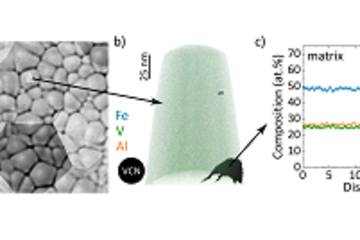All genres
381.
Talk
Correlated and simulated electron microscopy and atom probe tomography. Workshop on Possibilities and Limitations of Quantitative Materials Modeling and Characterization 2017, Bernkastel, Germany (2017)
382.
Talk
A Brief History of Metals. Public Named Max Planck Lecture, MPIE Düsseldorf, Düsseldorf, Germany (2017)
383.
Talk
Advanced Atom Probe Tomography. 25th Annual Meeting of the German Crystallographic Society, Karlsruhe, Germany (2017)
384.
Talk
Atomic Scale Characterization of Complex Materials. Physikalisches Kolloquium, Fakultät für Mathematik und Physik, Universität Freiburg, Freiburg, Ger,amy (2017)
385.
Talk
New insights in the atomic interface structure of kappa carbides in high-Mn steels. TMS2017, San Diego, CA, USA (2017)
386.
Talk
Grain growth and dewetting of thin Al films on (0001) Al2O3 substrates. 3 Phase, Interface, Component Systems (PICS), Centre Interdisciplinaire de Nanoscience de Marseille (CINaM), Marseille, France (accepted)
387.
Talk
In-situ Transmission Electron Microscopy Observation of Heat-Induced Structural Changes of 3D Nb3O(OH) Networks. Electronic Materials and Applications 2017 (EMA), Orlando, FL, USA (2017)
388.
Talk
Ab-Initio Guided Design of Twinning Induced Plasticity and Weight Reduced Austenitic Steels. MRS Fall Meeting, Boston, MA, USA (2016)
389.
Talk
Insights into structural and functional properties of Nb3O7(OH) and TiO2 nanoarrays. European Materials Research Society’s (EMRS) Fall Meeting, Warsaw, Poland (2016)
390.
Talk
Transmission electron microscopy – a versatile tool to study the microstructure of HT-PEMFC. Materials Science 2016, Atlanta, GA, USA (2016)
391.
Talk
Time and temperature study on solvothermally grown CuInS2 layers for green energy applications. JuniorEUROMAT, Lausanne, Switzerland (2016)
392.
Talk
Atoms, ions, electrons: simulated, measured and manipulated. Workshop on Scientific Directions for Future Transmission Electron Microscopy, Jülich, Germany (2016)
393.
Talk
Chemo-Mechanics at Lattice Defects: from Mechanisms to Bulk Alloys. Gordon Research Conference on Thin Film & Small Scale Mechanical Behavior, Lewiston, ME, USA (2016)
394.
Talk
Defect Segregation studied by Correlative Atom Probe Tomography and Electron Microscopy. Japan-Germany Joint Symposium on Advanced Characterization of Nanostructured Materials for Energy and Environment, Conference Center Mutterhaus, Düsseldorf, Germany (2016)
395.
Talk
Insights into structural and functional properties of nano-structured electrodes for energy and fuel generating devices. Talk at Helmholtz‐Zentrum Geesthacht, Geesthacht, Germany (2016)
396.
Talk
Correlative STEM & Atom Probe Tomography (ATP): Insights in the k-carbide/austenite interface. Workshop on “New trends in electron microscopy”, Ringberg Castle, Kreuth am Tegernsee, Germany (2016)
397.
Talk
The role of defects in Nb3O7(OH) and TiO2 nanoarrays. Energy Materials Nanotechnology (EMN), Dubrovnik, Croatia (2016)
398.
Talk
Are Mo2BC nanocrystalline coatings damage resistant? Insights from comperative tension experiments. 62. Metallkunde-Kolloquium, Werkstoffforschung für Wirtschaft und Gesellschaft , Lech am Arlberg, Austria (2016)
399.
Talk
Insights into degradation processes in WO3-x based anodes of HT-PEMFCs via electron microscopic techniques. Fuel Cells Science and Technology 2016 , Glasgow, Scotland, UK (2016)
400.
Talk
Defects in as-grown vs. annealed rutile titania nanowires and their effect on properties. EMC 2016, 16th European Microscopy Congress, Lyon, France (2016)










